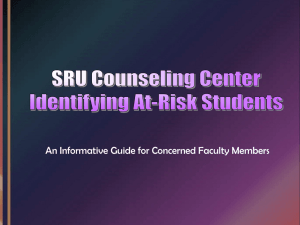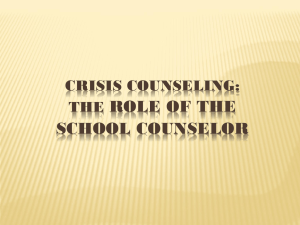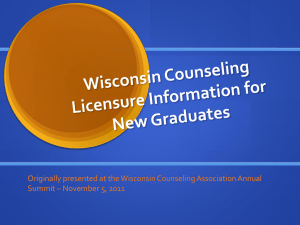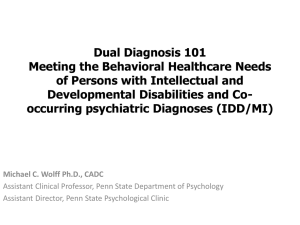MyApproachtoIndividualCounseling
advertisement
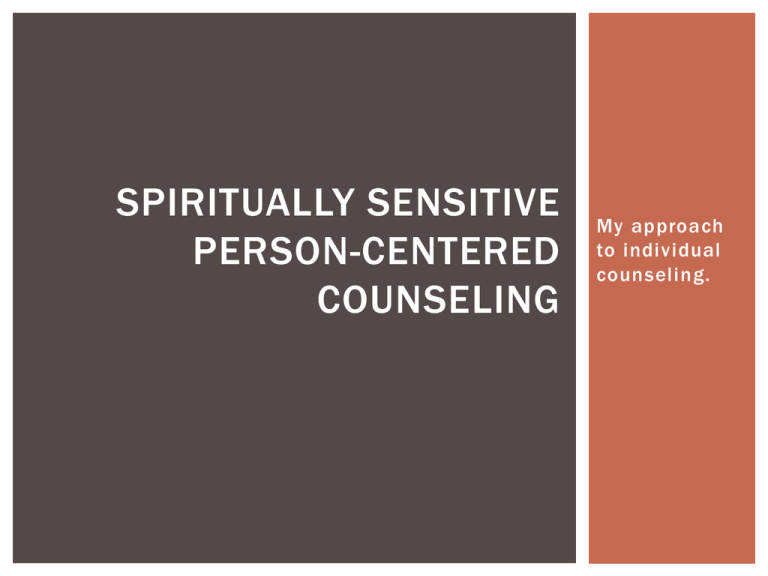
SPIRITUALLY SENSITIVE PERSON-CENTERED COUNSELING My approach to individual counseling. WILLIAM JAMES & CARL ROGERS My approach combines the pluralism of William James with the incongruence and empathy of Carl Rogers. WILLIAM JAMES William James is the author of The Varieties of Religious Experience (1902/2004). “Although all the special manifestations of religion may have been absurd (I mean its creeds and theories), yet the life of it as a whole is mankind’s most important function” (Letter to Miss Frances R. Morse, in The Letters of William James, vol II, 1920, p. 127). WILLIAM JAMES, CON’T Monists view the soul as an illusion and the body as the only reality. Dualists view the soul and body as two separate realities. William James was a pluralist, by which he meant: There is no system of rules that works in every situation or at all times. He considered monism a hypothesis -- and his intuition was that it was not a correct hypothesis. PLURALISM: AT LEAST 12 AREAS OF INCONGRUENCE, WHICH MAY OVERLAP 1. Physical. 2. Mental. 3. Emotional. 4. Attachment issues. 5. Social/relational. 6. Spiritual. 7. Moral. 8. Creative (the ways we see and express the world differently). 9. Revolutionary (the ways in which we wish the world were different). 10. Maslow’s basic needs: physiological, safety, love and belonging, esteem. 11. Maslow’s higher needs: self -realization, self-transcendence. 12. Meaning and meaningful work. INCONGRUENCE We do not experience in feedback from others what we expect and want to experience and/or We do not feel we can honestly and accurately communicate our feelings &/or thoughts in a relationship . When we are congruent in a communication w/ another, we are authentic with that person. If the client does not feel that there is an incongruence in their life and a need for congruence and authenticity, then no amount of counseling will result in inner or inter -personal growth. One possible exception may be group counseling, which can inspire and resolve incongruence. SPIRITUALLY SENSITIVE PERSONCENTERED COUNSELING IS: Psychological contact. Incongruence in any of the 12 areas of concern for the client. Genuineness, authenticity, & congruence from the counselor. Unconditional positive regard and acceptance (non-possessory love/agape). Empathy. Perception by the client of the counselor’s empathy and acceptance. Understanding (of the client’s emotional, intellectual, spiritual, and moral concerns, and ability to restate those accurately). Privacy and Confidentiality. Patience and Optimism. KEEP TURNING THE CLIENT BACK TO THEIR OWN JUDGMENT The client may keep turning outside herself for guidance. S/he may look to a moral or religious code for guidance. S/he may look to her parents or family for guidance. S/he may look to the counselor for answers. The key is to keep tuning the client back into her/himself for guidance. The counselor does this by repeating his/her understanding of the client’s meanings and feelings in each of 12 critical areas of incongruence and Waiting for the client to re -voice her/his concerns again. With each re-statement, the client will go deeper and arrive closer to an accurate expression of her true -self. PROCESS VS. CONTENT These are all matters of process. They all concern how to approach the client, not what the client is expected to learn. The only additions to Rogers are explicitly naming the 12 critical areas, including spiritual and moral. These additions are tacit and need never be made explicit unless the client leads there. WHY IS THE COUNSELOR NEEDED? If counseling is all a process and just a matter of referring the client back to their own judgment, why is the counselor needed? Because: Existential philosophy pointed out it takes two to create meaning. Growth takes two: one to grow and the other to witness and validate that growth. Mental health is relational experience. Without the counselor’s prodding, we would become lazy. Without the counselor’s reflecting our meaning accurately and empathically, we would loose faith in ourselves. YES & NO We require some positive feedback (some smiles). A little “yes” goes a long way. NEGATIVE FEEDBACK For dialogue and learning and growth, we must also have a little “no,” a little negative feedback, a little conflict between our worldview and the world’s view of us. Many person’s self-esteem is so fragile that even a little negative feedback can be devastating – especially coming from a person of power and authority such as the counselor. They have received negative feedback all their lives: from parents, teachers, et al. They already carry that negative, critical voice inside them. Who are we to tell them what is “right” for them ? They must figure out what is right for them. NEGATIVE FEEDBACK, CONTINUED: To be ef fective in counseling, all the “no” must come from within the client. It must be a “no” that is congruent with the client’s true -self, not imposed from without. Clients can be trusted to continue to question themselves until they feel Ok about themselves alone and in relationships. That is the goal of therapy; not for the client to behave in ways that are Ok with the therapist (or anyone else, including other family members), but to behave in ways that are Ok w/ the client’s true -self. The counselor’s job is limited to correctly and empathically reflecting the client’s meanings and feelings in 1 2 problematic areas. Then waiting for the client to re -state their own concern again: with each re-statement, the client will go a little deeper, get a little closer to expressing themselves authentically. The client will take it from there: I believe each individual is a soul who has infinite capacity for growth – and desire to grow. Each client knows in what ways they need and want to grow . We, client and counselor, also need occasional breaks . THE END

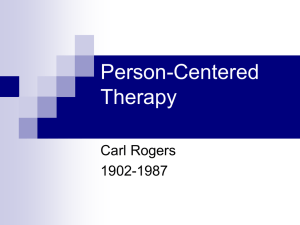

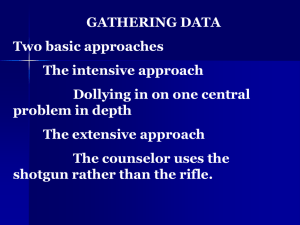
![Welcome and keynote [PPTX] - University of California](http://s2.studylib.net/store/data/005379330_1-defe5a320244e6e9135ed98fd0853e39-300x300.png)

